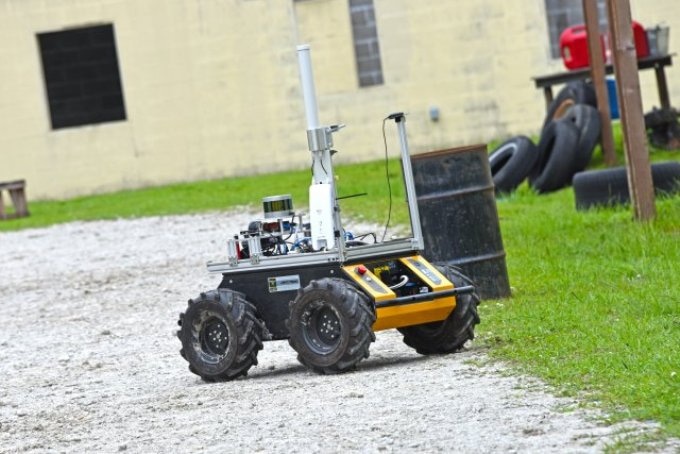Nov 22 2019
An Army-led team of researchers has come up with new algorithms and has bridged knowledge gaps related to how robots contribute to teams and what robots know about their surroundings and teammates.
 The Clearpath Husky, used as a research platform, is used to develop and test underlying autonomy to support context-driven AI that supports effective bidirectional communication. Image Credit: U.S. Army Photo.
The Clearpath Husky, used as a research platform, is used to develop and test underlying autonomy to support context-driven AI that supports effective bidirectional communication. Image Credit: U.S. Army Photo.
Dr Kristin Schaefer-Lay, an engineer with the U.S. Army Combat Capabilities Development Command’s Army Research Laboratory, is part of a multidisciplinary team of scientists from the Army, Carnegie Mellon University, University of Minnesota, and the University of Central Florida, among others, who created dedicated algorithms and innovative artificial intelligence (AI) methods to help develop shared context between team members via productive bidirectional communication.
The idea of integrating context to AI development is a difficult process. Researchers tend to have very different ideas about what is meant by context and the best practices for integrating context into AI development.
Dr Kristin Schaefer-Lay, Engineer, U.S. Army Research Laboratory
Several researchers and institutions have dealt with smaller fragments of this problem set, but this team focused on a more holistic method to develop and incorporate various types of context related to mission context, environmental context, and social context to develop human-autonomy teaming via innovative bidirectional communication capabilities.
This has led to the direct advancement of science in robotics and AI processes in the areas of world model development, natural language communication, human-autonomy teaming, and multi-modal communication, stated Schaefer-Lay.
The collaborative team aims to identify crucial scientific advances achieved by the Army’s Robotics Collaborative Technology Alliance (RCTA) on methods for creating and advancing context-driven AI to assist future human-autonomy teams.
Planned investments in Army-led foundational research as part of the RCTA led to advanced science in four important areas of ground combat robotics that influence the way U.S. warfighters observe, think, move, and collaborate. This study assists the Army Modernization Priority for the Next-Generation Combat Vehicle by achieving advancement in science for incorporating context-driven AI within human-autonomy teams.
Government investment in ground combat robotics is critical to ensuring U.S. maneuver forces maintain a marked combat advantage.
Dr Kristin Schaefer-Lay, Engineer, U.S. Army Research Laboratory
The team reported the study outcomes in the September 30th edition of the AI Magazine as part of an invited issue on AI and Context: “Integrating Context into Artificial Intelligence: Research from the Robotics Collaborative Technology Alliance.”
Incorporation of context-driven AI is vital for future robotic capabilities to help develop situation awareness, calibrate suitable trust, and enhance team performance in collaborative human-robot teams.
This study underscores the advancements in context-driven AI for human-robot teaming.
Research possibilities include how context enables robots to bridge the gaps to make effective decisions more swiftly, supports more robust behaviors, and augments robot communications to match the requirements of the team under different environments and team organizations, as well as across missions.
The study outcomes will be used to help the laboratory’s continued research in the Human-Autonomy Teaming Essential Research Program. Specifically, this study will support the development of effective bidirectional communication approaches and interventions for calibrating suitable team trust and shared situation awareness in hazardous and complex operations.
According to Schaefer-Lay, it is not just sufficient to develop new algorithms and methods, “but it is important to understand the impact these have on effective teaming across operations.”
The progress achieved in this line of research will expand to include larger teams and crew station technologies that promote the Next-Generation Combat Vehicle, she said.